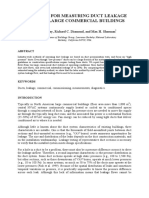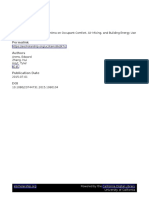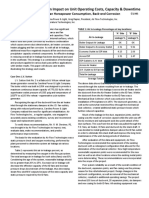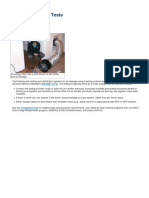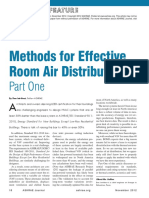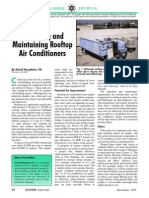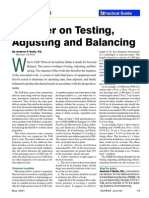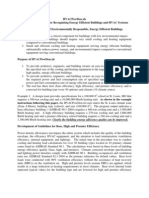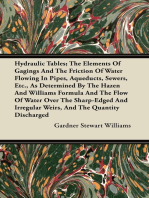2005 03 ASHRAE Standard 152 & Duct Leaks in Houses - Modera
2005 03 ASHRAE Standard 152 & Duct Leaks in Houses - Modera
Uploaded by
meomeportabCopyright:
Available Formats
2005 03 ASHRAE Standard 152 & Duct Leaks in Houses - Modera
2005 03 ASHRAE Standard 152 & Duct Leaks in Houses - Modera
Uploaded by
meomeportabOriginal Title
Copyright
Available Formats
Share this document
Did you find this document useful?
Is this content inappropriate?
Copyright:
Available Formats
2005 03 ASHRAE Standard 152 & Duct Leaks in Houses - Modera
2005 03 ASHRAE Standard 152 & Duct Leaks in Houses - Modera
Uploaded by
meomeportabCopyright:
Available Formats
The following article was published in ASHRAE Journal, March 2005.
© Copyright 2005 American Society of Heating, Refrigerating and
Air-Conditioning Engineers, Inc. It is presented for educational purposes only. This article may not be copied and/or distributed electronically
or in paper form without permission of ASHRAE.
ASHRAE Standard 152
& Duct Leaks in Houses
By Mark Modera, Ph.D., P.E., Member ASHRAE
D
o ducts in houses leak? Tests have shown that in most houses
the answer is yes, and most of those ducts leak enough to merit
sealing. Duct leaks create uncontrolled airflows with consequences house required duct improvement ser-
vices, as well as while the dealer was
that include low pressure zones, increased infiltration that can increase performing duct improvement services
or decrease humidity, nonuniform temperatures, and energy/capacity in houses that needed them.
Dealers performed a house pressure
losses for the HVAC system. test, which measures the change in house
pressure associated with turning on the
This article discusses data collect- the flow through those ducts, and of the HVAC system fan. The test distinguishes
ed from thousands of houses around type of HVAC equipment to which they houses that really need duct sealing,
the country and also discusses ANSI/ are connected. In addition, the standard those that might benefit from sealing,
ASHRAE Standard 152–2004, A Method allows comparison of the efficiency of and houses in which the cost of sealing
of Test for Determining the Design and using hydronic baseboards vs. installing is probably not justifiable.
Seasonal Efficiencies of Residential a duct system in a new house. Supply leaks to the outdoors cause the
Thermal Distribution Systems. house pressure to decrease when the fan
The standard quantifies how much Duct Performance Data is turned on, while return leaks increase
energy and HVAC equipment capacity Over the past decade or so, increasingly house pressure. As a result, the house
duct leaks actually waste. In addition, more groups have measured field perfor-
it calculates the energy and capacity mance of residential HVAC systems.1–7 About the Author
implications of where the ducts are lo- The previously unreported data presented Mark Modera, Ph.D., P.E., is vice president for
strategic operations at Carrier-Aeroseal, Syracuse,
cated (attic vs. crawlspace vs. basement, here was collected by residential HVAC N.Y.; a staff scientist at Lawrence Berkeley National
as well as Miami vs. Minneapolis), of dealers as part of a diagnostic test to de- Laboratory, Berkeley, Calif.; and was chair of Stan-
the insulation level of those ducts, of termine whether a particular customer’s dards Project Committee 152.
28 ASHRAE Journal ashrae.org March 2005
Duct leaks create uncontrolled airflows with consequences
that include low pressure zones, increased infiltration that
can increase or decrease humidity, nonuniform temperatures,
and energy/capacity losses for the HVAC system.
pressure test detects leakage only to outside—to or from a grille in a house. The results in Figure 2 represent the sum
vented attic or crawlspace. of each house’s register flows divided by the nominal cool-
The situation becomes more complicated when both supply ing capacity of the HVAC equipment. These results can be
and return ducts are leaking. In this case the pressure change compared to a nominal flow of 400 cfm/ton (54 L/s per kW),
is proportional to the difference between the two leakage rates, which is where most residential air conditioners are rated for
not the sum of the leakage rates (e.g., the pressure change would efficiency and capacity.
be zero if they are both leaking the same amount, even if the The significant difference between the actual flows in Figure
leakage flows are very large). 2 and 400 cfm/ton (54 L/s per kW) stems predominantly from
To distinguish tight ducts from equally leaky ducts, the two effects: 1) supply duct leakage, and 2) excessive resistance
house pressure test includes a second step: partially blocking to airflow. The particularly low register flows in the Illinois
the return grilles, increasing the pressure differences across data are most likely due to the larger quantity of leaks in the
the return leaks and decreasing the pressure differences across rectangular sheet-metal duct systems typically found in that
the supply leaks. If the ducts are tight, changing their pressures region (see Figure 4 and associated discussion).
does not affect the house pressure. However, if supply leakage As noted earlier, fan flow, duct leakage and duct insulation
was masking return leakage, the return-blocked test will make all impact the temperature of the air leaving the grilles. Figure
the return leaks more prominent. 3 shows the results of register temperature measurements in
One complication is that the leakage of the shell of the house almost 2,000 houses. The data presented are based upon tem-
determines the magnitude of the pressure change associated perature measurements at all supply and return grilles.
with a given duct leakage flow. For that reason, this test is not The percentage loss in sensible capacity at any supply grille
a precise measurement of duct leakage, but an indicator that is calculated by dividing the temperature difference between
only gives one of three answers, as shown in Figure 1. that grille and the best supply grille, by the temperature dif-
Figure 1 shows results of approximately 1,000 house pressure ference between the best supply grille and the average of the
tests in Sacramento, Calif., and Austin, Texas. Both regions are return grilles (Equation 1).
predominated by attic duct installations of flex-duct systems.
Figure 1 demonstrates two interesting points: 1) between 60% % Thermal Loss = (Tbest-grille – Tgrille)/(Tbest-grille – Treturn-average) × 100
and 85% of the houses in these regions would benefit from duct (1)
sealing, and 2) the distribution of results is remarkably similar This procedure estimates the sensible capacity using the
in the two regions (we also found similar consistency between difference between the average return temperature and the best
dealers in each region). supply temperature, which in most cases is an underestimation
Another important aspect of duct performance is how much due to leakage and conduction losses between the return grille
air actually is delivered to the rooms being conditioned. Fig- and the air handler, and between the HVAC equipment and the
ure 2 shows results of another diagnostic test performed by best supply grille. These results are striking, as they indicate
the HVAC dealers to measure the airflow delivered by each that, on average, between a quarter and a third of the registers
March 2005 ASHRAE Journal 29
350
Sacramento Avg. (783 Tests) Austin Avg. (199 Tests) C
300
A
B
<15% 250
<15%
Flow (cfm/ton)
200
>25% >25% 150
15% – 25% 15% – 25%
100
50
0
Sacramento Sacramento Sacramento Bakersfield Illinois
2,159 Houses 1,898 Houses 556 Houses 47 Houses 42 Houses
Figure 1 (left): Distributions of house pressure test results, where percentages are combined supply and return duct leakage as a fraction
of HVAC fan flow. Averages are for all participating dealers in the region. Figure 2 (right): Register flow measurement results. A, B, and
C refer to different dealers.
4.5 C 900
4.0 800
Leakage (cfm @ 25 Pa)
3.5
Number of Registers
700
B
3.0 A 600
2.5 500
A
2.0 400 C
B
1.5 300
1.0 200 New
Construction
0.5 100
0.0 0
Sacramento Sacramento Sacramento Bakersfield Illinois Sacramento Sacramento Sacramento Bakersfield Illinois
525 Houses 960 Houses 374 Houses 32 Houses 26 Houses 443 Houses 279 Houses 110 Houses 1,231 Houses 1,065 Houses
Figure 3 (left): Results of register temperature measurements (registers with greater than 25% thermal loss are within a given house). A, B,
and C refer to different dealers. Figure 4 (right): Results of fan-pressurization tests of duct leakage. A, B, and C refer to different dealers.
are losing more than 25% of the sensible capacity provided and measured fan flows to calculate duct leakage as a fraction
by the equipment. Moreover, whether the loss is caused by of fan flow. Also the house would need to be simultaneously
leakage, low flow, or poor insulation, these calculated losses pressurized to the same pressure as the ducts to isolate duct
represent only the thermal conduction loss on the supply side, leakage flows to/from outside the house.
which would apply to the flow being delivered after the supply Figure 4 suggests some interesting trends. First, the three
leakage has been subtracted. dealers in Sacramento all measured approximately the same
The data presented in Figures 1 through 3 was obtained level of leakage, which one would hope to find. This is consis-
during diagnostic services, while Figure 4 presents the tent with the house pressure test results. Second, the leakage
results of fan pressurization tests of total (i.e., supply plus levels in new Bakersfield, Calif., construction are considerably
return) duct leakage performed just prior to sealing in almost lower than the data from existing houses in Sacramento. This
3,000 houses. also is consistent with the assumptions within the California
As compared to the house pressure test, these results are Energy Efficiency Standards about duct leakage in new vs.
more precise and repeatable, although they represent a differ- existing buildings. However, the same dealer installed the duct
ent leakage characteristic, namely the flow through all supply systems being sealed, and, therefore, had an incentive to mini-
and return leaks at a fixed reference pressure. The unit, cfm at mize leakage introduced during the installation process.
25 Pa (0.1 in. w.g.), represents the leakage flow at a reference The other key trend in Figure 4 is that the data from Illinois
pressure differential of 25 Pa (0.1 in. w.g.) (considered repre- shows significantly higher leakage levels, which is consistent
sentative of the average pressures across leaks during normal with other studies of rectangular sheet-metal duct systems
operation) created by the duct pressurization fan. in basements.*
It also represents a combination of SI and I-P units, and This type of duct construction has much more extensive
unfortunately has become the typical unit of reporting. To
*A comparison of the leakage data in Strunk, et al., 1996, with Jump and Modera,
compare these leakage values with house pressure test results, 1994, shows that the floor-area-normalized duct leakage flow at 25 Pa (0.1 in. w.g.) was
they must be combined with measured operating pressures more than three times as much in the basement houses.
30 ASHRAE Journal ashrae.org March 2005
100% 45%
90% 3%/3% R-4.2
40% 15%/15% R-4.2 Crawl
80% 3%/3% R-38
35%
70%
60% 30%
50% 25%
40%
20%
30%
15%
20%
10%
10%
0% 5%
Heating, Heating, Cooling, Cooling,
Design Seasonal Design Seasonal 0%
15%/15% R-4.2 3%/3% R-4.2 Heating, Heating, Cooling, Cooling,
3%/3% R-8 3%/3% R-38 Design Seasonal Design Seasonal
Figure 5 (left): Application of Standard 152 to an attic flex-duct system in Sacramento shows the attic duct efficiency. Figure 6 (right):
Savings calculated with Standard 152 for changes to an attic flex-duct system in Sacramento.
return duct systems and many more joints as compared to plastic project committee in 1993 that ultimately developed Standard
flex-duct systems; common practice in residential basement 152.
construction does not include sealing those joints. Standard 152 was developed to provide a means for rating
In addition, a small fraction of the Illinois houses had the performance of different thermal distribution systems.
building cavity returns, which generally have higher leakage Its scope was limited to air systems, hydronic systems, and
as compared to sheet-metal systems. One caution relative to electric systems.
all of the data in Figure 4 is that some measurements include Minimum inputs for rating a duct system are:
both supply and return leakage, whereas other measurements • Duct leakage (supply and return);
include only one side of the fan. Based upon conversations with • Duct location (e.g., attic, crawlspace, basement);
the dealers who took the data, • Duct insulation level;
the Illinois data contains many 100% • House location (from a list
more single-sided measure- 90% of cities); and
ments. This suggests that the 80% • HVAC equipment char-
ratio of leakage areas between 70% acteristics (type [e.g. heat
rectangular sheet-metal base- 60% pump], capacity, fan flow).
ment ducts and attic flex-duct 50% The outputs are:
systems is underestimated by 40% • Heating design efficien-
this data. 30% cy;
Something else to keep in 20% • Heating seasonal eff i-
mind when comparing attic 10% ciency;
and basement construction is 0% • Cooling design efficiency;
Heating, Heating, Cooling, Cooling,
that the pressure differentials Design Seasonal Design Seasonal and
seen by the leaks in basement 30%/30% R-1.5 5%/5% R-1.5 5%/5% R-8 • Cooling seasonal eff i-
systems are typically smaller 30%/30% R-1.5 Wall Insulation 30%/30% R-1.5 Ceiling Insulation ciency.
than those in attic systems. Based upon the inputs,
Figure 7: Application of Standard 152 to a basement system in
The net result is that a reason- Chicago shows the basement duct efficiency. Standard 152 first calculates
able estimate of leakage for the fraction of the condition-
attic flex-duct systems is 15% to 20% of fan flow on each side ing produced by the HVAC equipment that is delivered at the
of the fan,3 while rectangular sheet-metal duct systems have supply registers. The standard calculates this fraction, called
more like 25% to 30% leakage on each side of the fan. the delivery effectiveness, using fixed algorithms to calculate
the temperatures in each duct zone using the local climate
ASHRAE Standard 152 conditions.
As duct leakage and temperature loss data began to appear in The local climate conditions are ASHRAE Handbook design
the early 1990s, concerns quickly arose about how to interpret values for the design efficiencies, while the seasonal climate
that data. These concerns led to the formation of a standards conditions are based upon load-weighted seasonal averages of
March 2005 ASHRAE Journal 31
hour-by-hour climate data. The zone-temperature algorithms which accounts for the fact that the extra load associated with
include effects such as the presence of a radiant barrier in an at- duct losses increases the use of electric resistance heating by a
tic, and the location of wall and ceiling insulation in basements. heat pump. At a delivery effectiveness of 0.75, the equipment
For example, Standard 152 temperatures for a well-vented attic interaction factor reduces the distribution efficiency by 14%.
are Tdesign + 22°F at design conditions, and + 13°F for
seasonal efficiency calculations. Example Applications of Standard 152
Standard 152 then calculates the overall distribution effi- Some examples of efficiencies calculated with Standard
ciency, adjusting the delivery effectiveness by the fraction of 152 are illustrated in Figures 5 through 7. Figure 5 shows dis-
energy losses that are recovered into the conditioned space. The tribution efficiency results for Sacramento at different levels
regain factors are based upon the ratio of the thermal conduc- of duct leakage and insulation. It shows that efficiencies for a
tance between the duct zone and the conditioned space, to the duct system with R-4.2 duct insulation and the leakage levels
overall thermal conductance of the duct zone. Typical regain observed in the field for existing houses (15% supply, 15%
values are 10% for a vented attic, 50% for an uninsulated base- return) range from 53% for cooling under design conditions
ment, 75% for a basement with insulated walls, and 30% for a to 75% for the average value over the heating season. Figure 5
basement with an insulated ceiling. also shows that sealing the duct leakage has the largest impact,
Standard 152 also accounts for interactions between HVAC and that the combination of sealing and super-insulation of the
equipment and ductwork, including the effect of ductwork ducts (e.g., burying them in loose-fill insulation) can bring all
losses on equipment operating mode, as well as the effect efficiencies above 90%.
on equipment efficiency of low fan flows. For example, the Figure 6 compares the savings that can be achieved by differ-
equipment interaction factor (which multiplies the delivery ent duct system improvements in Sacramento and demonstrates
effectiveness) for a heat pump is: that moving the ducts from the attic to the crawlspace has little
impact on heating, but produces cooling savings similar to those
Fequip = 0.44 + 0.56 × (Delivery Effectiveness) (2)
achieved by sealing the attic ducts. Figure 6 also illustrates the
Advertisement formerly in this space.
32 ASHRAE Journal ashrae.org March 2005
dramatic impacts of duct improvements on cooling efficiency at
design conditions, which translates to comparable impacts on
overall cooling system capacity at design conditions.
Figure 7 presents duct efficiencies for basement ducts in
Chicago. At typical unsealed leakage levels of 30% supply
and 30% return for an uninsulated metal duct system in an
uninsulated basement, cooling efficiencies still are considerably
higher than for attic ducts in Sacramento, due to the coolness of
the basement.8 Figure 7 also shows the impacts of duct sealing
and insulation, as well as the impacts of basement insulation
and location.
Measurement Procedures in Standard 152
In addition to standardizing calculation procedures, Standard
152 also specifies two procedures for measuring duct leakage
and two procedures for measuring HVAC system fan flow. The
two duct leakage test procedures both include calibrated-fan
pressurization of the duct system. The first procedure pressur-
izes the house with a blower-door fan to the same pressure as the
duct system and measures duct leakage to outside. The second
procedure pressurizes the ducts only, thereby measuring total
duct leakage. The standard only allows the second procedure
to be applied to duct systems having leakage levels of less than Advertisement formerly in this space.
10% of fan flow. For either test, to adjust fixed-pressure duct
leakage flows to the specific systems being tested Standard
152 also specifies procedures for measuring the duct system
operating pressures.
The two procedures within Standard 152 for measuring fan
flow are: 1) a method that involves substituting a calibrated-plate
for the system filter, and 2) a method that involves substituting
a calibrated fan for the return ductwork. Method 2 works by
adjusting the calibrated fan speed to produce the same supply
plenum pressure as found during normal operation.
References
1. Cummings, J.B., R. Dunsmore, and J.J. Tooley, Jr. 1990. “Impacts
of duct leakage on infiltration rates, space conditioning energy use, and
peak electrical in Florida homes.” Proceedings of ACEEE.
2. Jump, D.A. and M.P. Modera. 1994. “Impacts of attic duct retrofits
in Sacramento houses.” Proceedings of ACEEE.
3. Jump, D.A., I.S. Walker and M.P. Modera. 1996. “Field mea-
surements of efficiency and duct retrofit effectiveness in residential
forced-air distribution systems.” Proceedings of ACEEE.
4. Modera, M.P. 1993. “Characterizing the performance of residen-
tial air distribution systems.” Energy and Buildings 20(1):65–75..
5. Modera, M.P. and D.A. Jump. 1995. “Field measurements of
the interactions between heat pumps and duct systems in residential
buildings.” Proceedings of ASME International.
6. Palmiter, L. and P.W. Francisco. 1996. “Measured efficiency
of forced-air distribution systems in 24 homes.” Proceedings of
ACEEE.
7. Strunk, P.R., et al. 1996. “Stock characterization and energy
savings potential in forced air systems in frostbelt homes.” Proceed-
ings of ACEEE.
8. Treidler, E.B. and M.P. Modera. 1996. “Thermal performance
of residential duct systems in basements.” ASHRAE Transactions
102(1): 847–858.
March 2005 ASHRAE Journal 33
You might also like
- Hvac Duct Air Leakage 9 12 19Document7 pagesHvac Duct Air Leakage 9 12 19Marinos GounaridisNo ratings yet
- Advanced Temperature Measurement and Control, Second EditionFrom EverandAdvanced Temperature Measurement and Control, Second EditionNo ratings yet
- Arsitektur, Struktur & MEP-1Document128 pagesArsitektur, Struktur & MEP-1JokoNo ratings yet
- The Segal MethodDocument1 pageThe Segal MethodGonzalo Agulló FernándezNo ratings yet
- Energy Losses in Bends Lab ReportDocument14 pagesEnergy Losses in Bends Lab ReportJemuel FloresNo ratings yet
- Piping System DesignDocument66 pagesPiping System DesignChinmoy12533995100% (3)
- Assignment MechanicalDocument5 pagesAssignment MechanicalSoufiane RamdaniNo ratings yet
- Duct TesterDocument2 pagesDuct TesterDevrim GürselNo ratings yet
- Documento - Teste de Estanquidade em DutosDocument5 pagesDocumento - Teste de Estanquidade em DutosRogerio OliveiraNo ratings yet
- Car That Runs On Tap Water - Plasma Spark - Oct 2005 - Hydrogen Fuel - Free Energy - Stanley MeyerDocument139 pagesCar That Runs On Tap Water - Plasma Spark - Oct 2005 - Hydrogen Fuel - Free Energy - Stanley MeyerGheorghe SilviuNo ratings yet
- Rationale For Measuring Duct Leakage Flows in Large Commercial BuildingsDocument6 pagesRationale For Measuring Duct Leakage Flows in Large Commercial BuildingsSunish MithalNo ratings yet
- Duct Heat LossDocument5 pagesDuct Heat Losser_ranga1523No ratings yet
- Air Duct LeakageDocument4 pagesAir Duct Leakagephyolwin ooNo ratings yet
- Measure of Out Side Air Flow in To The SystemDocument13 pagesMeasure of Out Side Air Flow in To The SystemVishakpvaNo ratings yet
- Air Distribution System Case StudyDocument16 pagesAir Distribution System Case Studytmy3dataNo ratings yet
- Airbase 11867Document13 pagesAirbase 11867omarNo ratings yet
- Effect of Diffuser Minimum Airflow On Occupant Comfort and Energy UseDocument40 pagesEffect of Diffuser Minimum Airflow On Occupant Comfort and Energy UseReginaNo ratings yet
- 2005 06 HVAC Retrofit - Fixing Duct Leaks in Commercial Buildings - ModeraDocument7 pages2005 06 HVAC Retrofit - Fixing Duct Leaks in Commercial Buildings - ModerameomeportabNo ratings yet
- 1995 Case Study CP&L Air In-Leakage Resolution Impact On ESP Costs & DowntimeDocument2 pages1995 Case Study CP&L Air In-Leakage Resolution Impact On ESP Costs & DowntimeMohandas paiNo ratings yet
- Total Duct Leakage TestsDocument16 pagesTotal Duct Leakage Testssamira bashirvandNo ratings yet
- Ductwork Leakage & Leak Testing JournalDocument9 pagesDuctwork Leakage & Leak Testing JournalAlex ChinNo ratings yet
- LBL 35700 PDFDocument16 pagesLBL 35700 PDFnaser712No ratings yet
- 05 13 Eco Forum PDFDocument5 pages05 13 Eco Forum PDFakhilsureshNo ratings yet
- Duct Leakage& Leakage TestingDocument5 pagesDuct Leakage& Leakage Testinghoangdungd12No ratings yet
- Pure Power Spring 08Document5 pagesPure Power Spring 08Nandkishore Paramal MandothanNo ratings yet
- Increasing Heat Exchanger PerformanceDocument13 pagesIncreasing Heat Exchanger Performanceimtinan mohsinNo ratings yet
- Methods For Effective Room Air Distribution, Part 1Document6 pagesMethods For Effective Room Air Distribution, Part 1anescuveronicaNo ratings yet
- Duct Bank Thermal AnalysisDocument14 pagesDuct Bank Thermal Analysisap00No ratings yet
- Rooftop Wiring Methods and Temperature CorrectionDocument10 pagesRooftop Wiring Methods and Temperature CorrectionC GonzoNo ratings yet
- Heating Calculations For Electrical Duct Bank - C-S EngDocument10 pagesHeating Calculations For Electrical Duct Bank - C-S Engdavid_diaz_sNo ratings yet
- Air Flow FurnanceDocument26 pagesAir Flow FurnanceexperthvachomeNo ratings yet
- Business Management Article-Winter 2008Document5 pagesBusiness Management Article-Winter 2008PappuNo ratings yet
- Air Tightness of New U.S. HousesDocument14 pagesAir Tightness of New U.S. HousesSam WeberNo ratings yet
- HvacDocument4 pagesHvacFaiz MohNo ratings yet
- Duct Testing: Why Is It Important?: Technical SheetDocument4 pagesDuct Testing: Why Is It Important?: Technical Sheetsyedahmedali_276353No ratings yet
- High Rise Building EffectsDocument51 pagesHigh Rise Building Effectsdphilip96No ratings yet
- Operating and Maintaining Rooftop Air Conditioners: Ashrae JournalDocument5 pagesOperating and Maintaining Rooftop Air Conditioners: Ashrae Journal01566653No ratings yet
- Effects of Doors On Airflow and Cooling WP PDFDocument10 pagesEffects of Doors On Airflow and Cooling WP PDFdexiNo ratings yet
- Coil Capacity EfficiencyDocument3 pagesCoil Capacity EfficiencyChínhÂuNo ratings yet
- Hvac Thesis TopicsDocument5 pagesHvac Thesis Topicsgj3vfex5100% (2)
- 153 Nel Lombaard Liebenbergand Meyer 2009Document6 pages153 Nel Lombaard Liebenbergand Meyer 2009Sabareesh AthiNo ratings yet
- Fabric Duct AshraeDocument42 pagesFabric Duct Ashraehotmar ru100% (1)
- Model Energy Audit: Y CompanyDocument25 pagesModel Energy Audit: Y CompanyjoechengshNo ratings yet
- Testing, Adjusting & Balancing - ASHRAEDocument7 pagesTesting, Adjusting & Balancing - ASHRAEZainul Abedin Sayed100% (1)
- VAV vs. VCDDocument7 pagesVAV vs. VCDomarsosa#747No ratings yet
- Energy ManagementDocument8 pagesEnergy ManagementrezokaNo ratings yet
- Encyclopedia of Separation Science Part 2 (Elsevier)Document1,011 pagesEncyclopedia of Separation Science Part 2 (Elsevier)Pedro Javier Vargas MachadoNo ratings yet
- Airflow Uniformity Through Perforated Tiles in A Raised-Floor Data CenterDocument11 pagesAirflow Uniformity Through Perforated Tiles in A Raised-Floor Data CenterdexiNo ratings yet
- HVACPow Den InstructionsDocument5 pagesHVACPow Den InstructionsadamyzcNo ratings yet
- Temperature Effects For High-Velocity Gas FlowDocument5 pagesTemperature Effects For High-Velocity Gas FlowkronafNo ratings yet
- NFPA Standard 2001 12 Enclosure Testing Requirements PDFDocument4 pagesNFPA Standard 2001 12 Enclosure Testing Requirements PDFClifford Allen CooperNo ratings yet
- Models - Heat.shell and Tube Heat ExchangerDocument26 pagesModels - Heat.shell and Tube Heat ExchangerLuis Esteban Vela DonosoNo ratings yet
- Air-Tightness of U.S. DwellingsDocument16 pagesAir-Tightness of U.S. DwellingsSam WeberNo ratings yet
- ASHRAE SizingVAV BoxesDocument6 pagesASHRAE SizingVAV BoxesErica MorrisonNo ratings yet
- Design of Duct For A Three Storey Retail ShopDocument4 pagesDesign of Duct For A Three Storey Retail ShopAnonymous CUPykm6DZNo ratings yet
- Fin Pitch To Effect Efficiency of Evaporator and HVACDocument4 pagesFin Pitch To Effect Efficiency of Evaporator and HVACAJER JOURNALNo ratings yet
- Heating Systems Troubleshooting & Repair: Maintenance Tips and Forensic ObservationsFrom EverandHeating Systems Troubleshooting & Repair: Maintenance Tips and Forensic ObservationsNo ratings yet
- Diagnosis and Robust Control of Complex Building Central Chilling Systems for Enhanced Energy PerformanceFrom EverandDiagnosis and Robust Control of Complex Building Central Chilling Systems for Enhanced Energy PerformanceNo ratings yet
- The Handbook of Heating, Ventilation and Air Conditioning (HVAC) for Design and ImplementationFrom EverandThe Handbook of Heating, Ventilation and Air Conditioning (HVAC) for Design and ImplementationRating: 1 out of 5 stars1/5 (1)
- Hydraulic Tables; The Elements Of Gagings And The Friction Of Water Flowing In Pipes, Aqueducts, Sewers, Etc., As Determined By The Hazen And Williams Formula And The Flow Of Water Over The Sharp-Edged And Irregular Weirs, And The Quantity DischargedFrom EverandHydraulic Tables; The Elements Of Gagings And The Friction Of Water Flowing In Pipes, Aqueducts, Sewers, Etc., As Determined By The Hazen And Williams Formula And The Flow Of Water Over The Sharp-Edged And Irregular Weirs, And The Quantity DischargedNo ratings yet
- Estimator's Piping Man-hours Tool: Estimating Man-hours for Carbon Steel Process Piping Projects. Manual of Man-hours, ExamplesFrom EverandEstimator's Piping Man-hours Tool: Estimating Man-hours for Carbon Steel Process Piping Projects. Manual of Man-hours, ExamplesNo ratings yet
- 2012 07 Building Sciences - Thermal Bridge Redux - LstiburekDocument7 pages2012 07 Building Sciences - Thermal Bridge Redux - LstiburekmeomeportabNo ratings yet
- 2005 06 Emerging Technologies - Damper Diagnostics - FengDocument3 pages2005 06 Emerging Technologies - Damper Diagnostics - FengmeomeportabNo ratings yet
- 2005 04 Setting Fees For Profitable Green Building Projects - McGinnDocument5 pages2005 04 Setting Fees For Profitable Green Building Projects - McGinnmeomeportabNo ratings yet
- 2003 09 Refrigeration Applications - Efficiency For R-717 and R-22 Systems, Part 3 - BrileyDocument1 page2003 09 Refrigeration Applications - Efficiency For R-717 and R-22 Systems, Part 3 - BrileymeomeportabNo ratings yet
- 2012 10 Technical Feature - Long-Term Commercial GSHP Performance Part 4 Installation Costs - KavaaughDocument11 pages2012 10 Technical Feature - Long-Term Commercial GSHP Performance Part 4 Installation Costs - KavaaughmeomeportabNo ratings yet
- 2012 10 Technical Feature - Energy Audits, Improvements in Small Office Buildings - ShapiroDocument11 pages2012 10 Technical Feature - Energy Audits, Improvements in Small Office Buildings - ShapiromeomeportabNo ratings yet
- 2010 03 ASHRAE's Best - Commercial Refrigeration Green Warehouse - RoyDocument7 pages2010 03 ASHRAE's Best - Commercial Refrigeration Green Warehouse - RoymeomeportabNo ratings yet
- 2003 04 New Applications For Gas Cooling - RyanDocument4 pages2003 04 New Applications For Gas Cooling - RyanmeomeportabNo ratings yet
- 2012 05 International Column - EU Pump Regulations - BidstrupDocument5 pages2012 05 International Column - EU Pump Regulations - BidstrupmeomeportabNo ratings yet
- 2014 02 Technical Feature - Technical vs. Process Commissioning Design Phase Commissioning - McfarlaneDocument6 pages2014 02 Technical Feature - Technical vs. Process Commissioning Design Phase Commissioning - McfarlanemeomeportabNo ratings yet
- 2002 04 Legal Issues - Choosing A Business Structure - CallawayDocument1 page2002 04 Legal Issues - Choosing A Business Structure - CallawaymeomeportabNo ratings yet
- 2004 09 Building For The Future - Thermal Energy Storage in Sustainable Buildings - OlsenDocument5 pages2004 09 Building For The Future - Thermal Energy Storage in Sustainable Buildings - OlsenmeomeportabNo ratings yet
- Alok Infracon PVT LTD: Subject - Scope of Work Site - Caterpillar Signs PVT LTDDocument1 pageAlok Infracon PVT LTD: Subject - Scope of Work Site - Caterpillar Signs PVT LTDBrahammanand BairwaNo ratings yet
- Fire Protection: S76 Maintenance Training Manual CHC Training Centre (Global)Document39 pagesFire Protection: S76 Maintenance Training Manual CHC Training Centre (Global)FilipeDaumasNo ratings yet
- Ebe 3113 Concrete & Timber Technology IDocument3 pagesEbe 3113 Concrete & Timber Technology IDante MutzNo ratings yet
- Master Specification - Part Rd-Ew-C2 - Trench Excavation and BackfillDocument7 pagesMaster Specification - Part Rd-Ew-C2 - Trench Excavation and Backfillolgierd.karczmarzykNo ratings yet
- TFP228 08 2022Document5 pagesTFP228 08 2022mohammaddownloadingNo ratings yet
- Frames: SHEETDocument3 pagesFrames: SHEETSofia MalikNo ratings yet
- MEC-JTB-SF-M-DTS-900-00021 - 0 - 5-Datasheet - HP-Blowdown-Drum - (410-D-9001) - No comment.1-SA-NC (Code 1)Document5 pagesMEC-JTB-SF-M-DTS-900-00021 - 0 - 5-Datasheet - HP-Blowdown-Drum - (410-D-9001) - No comment.1-SA-NC (Code 1)Yusri FakhrizalNo ratings yet
- Higaonon Tree Hous1Document28 pagesHigaonon Tree Hous1Kyla GarciaNo ratings yet
- TORRE CONCRETO PREFABRICADA 1-Concrete-Wind-Towers-ChaseDocument28 pagesTORRE CONCRETO PREFABRICADA 1-Concrete-Wind-Towers-ChaserafaelzaramaNo ratings yet
- VRF IM BT 001 US - 014A06 - LGInstallManual - MultiVHydroKit PDFDocument84 pagesVRF IM BT 001 US - 014A06 - LGInstallManual - MultiVHydroKit PDFAlfred PonceNo ratings yet
- Weekly Work Done - DeckDocument8 pagesWeekly Work Done - DeckGogiNo ratings yet
- Home Construction Cost Calculator - UltraTechDocument4 pagesHome Construction Cost Calculator - UltraTechUjjwal Kumar ŪjsherNo ratings yet
- Section C-3a - Cathodic Protection Installation Method StatementDocument18 pagesSection C-3a - Cathodic Protection Installation Method StatementOkeymanNo ratings yet
- Standard Drawing 4201 High Profile Barrier Kerb Midwest Barrier KerbDocument1 pageStandard Drawing 4201 High Profile Barrier Kerb Midwest Barrier Kerbpresley.siaNo ratings yet
- Design of Roof Trusses CompressDocument24 pagesDesign of Roof Trusses CompresslucasNo ratings yet
- Excavation Is The Mechanical Removal of The Earth MaterialDocument6 pagesExcavation Is The Mechanical Removal of The Earth MaterialAzriel John SierraNo ratings yet
- Boreplan HDD Dia 710 - 200 MDocument1 pageBoreplan HDD Dia 710 - 200 MnNo ratings yet
- The Guild House Realrich Architecture WorkshopDocument1 pageThe Guild House Realrich Architecture Workshop99mhq2cbbkNo ratings yet
- Examining The Role of Building Envelope For Energy Efficiency in Office Buildings in IndiaDocument9 pagesExamining The Role of Building Envelope For Energy Efficiency in Office Buildings in IndiaReshma lalNo ratings yet
- Review of Related Literature: Property Characterization of Bamboo Reinforced Concrete Wall PanelDocument26 pagesReview of Related Literature: Property Characterization of Bamboo Reinforced Concrete Wall PanelRebecca BernardoNo ratings yet
- Mahle Air Filter (Primary) For CaterpillarDocument12 pagesMahle Air Filter (Primary) For Caterpillarsuraj pandeyNo ratings yet
- Odero,., Brian Jacks MSC Civil and Structural Engineering 2016Document135 pagesOdero,., Brian Jacks MSC Civil and Structural Engineering 2016amosomwega21No ratings yet
- Models Bif, BNFN, MDK, MBF and BNF: Standard-Stock Precision Ball Screw Unfinished Shaft EndsDocument12 pagesModels Bif, BNFN, MDK, MBF and BNF: Standard-Stock Precision Ball Screw Unfinished Shaft EndsSueli ZaniNo ratings yet
- Annexure 4-Scope of WorkDocument2 pagesAnnexure 4-Scope of WorkLogicInstitute TrainingBahrainNo ratings yet
- SL - No Particulars Units G.F Qtty Rate: (Car Parking)Document6 pagesSL - No Particulars Units G.F Qtty Rate: (Car Parking)ErMelvinDiasNo ratings yet
- Conbextra EP75: High Strength, Epoxy Resin GroutDocument4 pagesConbextra EP75: High Strength, Epoxy Resin GroutHamkarNo ratings yet
- Integrated Structural Health Monitoring of BridgesDocument77 pagesIntegrated Structural Health Monitoring of BridgesVirendra Kumar PareekNo ratings yet
- Building Attachment ReportDocument23 pagesBuilding Attachment ReportEugene OmondiNo ratings yet










